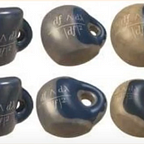Why is ℚ dense in ℝ?
We illustrate a simple proof for why the rational number field Q is dense in the real number field R.
Given E ⊂ X where E and X are both sets, we call E to be dense in X, when every point of X is either in E, or is a limit point of E.
Claim
Every real number in ℝ is either a rational number, or is a limit point of the rational numbers ℚ.
Why? Because in any ε-neighborhood of a real number x, you can always find a q ∈ ℚ such that x < q< x + ε. In other words, the open ball Br(x, ε) always have a non-empty intersection with the rational numbers.
This intuitively makes sense, because if we pick a random real number (x = 3.3333…) and an infinitesimally small ε-neighborhood (ε= 0.00001), we will always be able to find a rational number q such that 3.33333..< q < 3.33334.. In fact, there’s an infinite number of rational numbers in that interval.
Now let’s prove the following claim:
Claim
If x, y ∈ ℝ, and x < y, there exists a q ∈ ℚ such that x < q < y.
Proof
(To prove this claim, let’s assume we already know the archimedean property of ℝ, which states that there always exist n ∈ ℕ = {1, 2, 3, 4..} such that nx > y. In other words, you can always empty a bathtub of water y with n scoops of a tiny spoon x :).
To start with , since x < y, by the ordering of the real numbers, we have y - x < 0. By the archimedean property of ℝ, we can always find an n ∈ ℕ such that 1 < n(y - x). So 1 + nx < ny.
Next, we want to find an integer z such that z - 1 ≤ nx < z. So z is the smallest integer that is bigger than nx. Since nx is a real number, it is guaranteed to be bounded by 2 consecutive integers.
So now, we have nx < z < nx + 1. Combine with the inequality we had eaerlier, nx + 1 < ny, we get nx < z < ny. Hence, x < z/n < y. We have proved that between any two real numbers, there is at least one rational number.
In fact, taking the midpoint between nx and z, we will get another rational number. If we continue with this process, we will get an infinite number of rational numbers in between any 2 real numbers.
To conclude, we have shown why the rational number is dense in ℝ.
